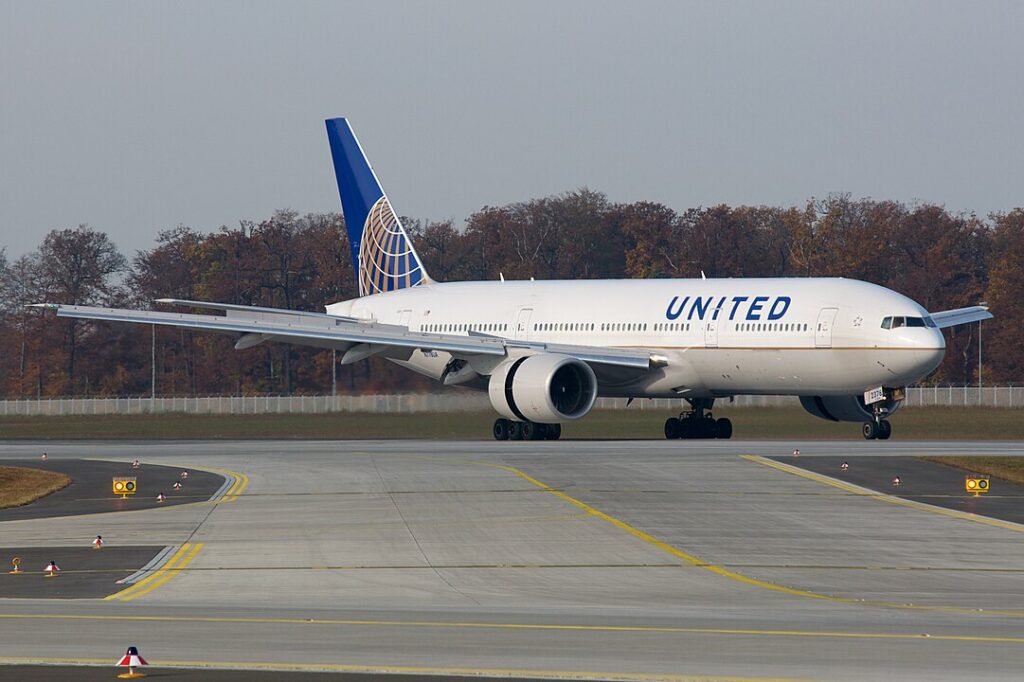WASHINGTON- The National Transportation Safety Board (NTSB) has attributed partial blame for the uncontained failure of the Pratt and Whitney PW4077 turbofan engine in 2021 to deficiencies in engine design and testing, as well as insufficient fan blade inspections.
In its final report released on September 8, the NTSB also highlighted that inspections conducted before the incident had identified signs of metal fatigue in the fan blade that ultimately failed. However, despite this evidence, the blade had not been taken out of service.

NTSB Blames Pratt and Whitney for PW4000 Failure
The report indicated that subsequent fleet-wide inspections of PW4000 engines identified an additional nine “confirmed cracked fan blades” since the incident occurred.
The incident involved a Pratt & Whitney PW4077 engine on the right wing of a United Airlines (UA) Boeing 777-200. Shortly after the aircraft’s departure from Denver on February 20, 2021, the turbofan experienced a dramatic failure, leading to the shedding of multiple engine components and a subsequent fire.
The aircraft returned safely to Denver, and no passengers or crew members were injured.
The NTSB’s report attributes the incident to metal fatigue, resulting in a full-length fan blade separation, setting off a series of events.
However, the report also highlights the contribution of inadequate inspections and design deficiencies to the incident. In response to this incident, the Federal Aviation Administration (FAA) issued an immediate directive for airlines to inspect PW4000 turbofan engines.
The report further notes that the engine’s damage was particularly severe due to shortcomings in Pratt & Whitney’s engine design and testing processes.
These shortcomings failed to ensure that the engine inlet could effectively dissipate the energy from an in-flight fan-blade separation event, thereby limiting further damage.

Problems with Engine Structural Design
The report highlights a significant discrepancy in Pratt & Whitney’s engine certification process. While the certification campaign for the engine had involved testing with an “aluminum structure inlet,” the engine that experienced the failure was equipped with composite components.
Simulation studies indicated that the carbon-fiber-reinforced plastic honeycomb structure of the affected engine’s inlet and inlet aft bulkhead could not effectively dissipate and redistribute the energy generated by the event, unlike the aluminum structure inlet used in certification tests.
The FAA issued three airworthiness directives in March 2022 in response to the incident. These directives mandated new inspections and modifications to strengthen engine cowlings, enhance engine fan-blade inspections, inspect various systems and components, and implement specific corrective actions based on inspection results.
The engine’s fan case had effectively contained the detached blade, but a “displacement wave” caused the fan case to deflect, leading it to impact the engine’s nacelle doors and hinges. This impact resulted in detaching the engine’s inlet and fan cowl components from the aircraft.
It’s important to emphasize that these failures should not have happened in accordance with FAA certification regulations. The NTSB points out that FAA certification rules mandate that fan blade failures should not lead to the separation of inlets and fan cowls.

Boeing Inlet Modifications
The report highlights that the fan blade failure was attributed to insufficient blade inspections, which failed to detect early indications of cracking, and the inadequate frequency of manufacturer-recommended inspection intervals. These factors allowed the low-level crack indications to propagate without detection.
“Subsequent to this incident, Boeing implemented modifications to the inlet to ensure the retention of inlets and fan cowls in place. These modifications also included enhancements to increase the strength and ductility of the inlet through the incorporation of additional metallic structure.”
NTSB
The report reveals that during the 2016 inspection, the failed blade displayed multiple low-level indications of an issue. These indications should have triggered a follow-up inspection and a team review.
However, no such actions were taken, and those involved in the inspection attributed the abnormality to “camera sensor noise or loose contamination.”
“Two of the low-level indications identified during the 2016 inspection were likely associated with the fatigue crack that ultimately led to the blade failure,” the report explains.
The blade underwent another inspection in 2018 and was subsequently returned to service. The NTSB notes that this incident marked the fourth in-service PW4000 failure due to fatigue cracking.
In response to the event, Boeing issued service bulletins that outlined modifications to inlet cowls and thrust reversers for 777 aircraft equipped with PW4000 engines.

NTSB Conclusion over PW4000 Failure
The NTSB’s report additionally states that the failure of the PW4077’s “K” flange resulted in the entry of “hot ignition gases into the nacelle, allowing the fire to propagate beyond the under-cowl area and into the thrust reversers, where it could not be extinguished.” This occurred approximately 6-9 minutes after the initial blade failure.
The report highlights that this situation violated certification standards, which mandate that these materials must be capable of withstanding fire for a minimum of 15 minutes, according to the NTSB.
The report further mentions that Pratt & Whitney is currently assessing measures to enhance the strength of the “K” flange and anticipates the availability of hardware for these improvements in 2025.
Stay tuned with us. Further, follow us on social media for the latest updates.
Join us on Telegram Group for the Latest Aviation Updates. Subsequently, follow us on Google News.

